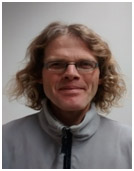Significance statement
This work demonstrates the effect of gas flow dynamics and plasma chemistry on the formation of small and large silicon nanocrystals (Si-NCs) synthesized in a remote expanding plasma, which is able to reach high throughputs of up to 10 g of silicon nanocrystals per hour of processing. Synthesized silicon nanocrystals have a bimodal size distribution and in the size range 2-10 nm and 50-120 nm, respectively. During synthesis, plasma expands in the form of a central beam surrounded by background recirculation zones. Transport of plasma species takes place in both of these regions. Central plasma beam has a directed flow with a residence time of 10 ms, while the recirculation cells are more stationary with a significantly longer residence time of 0.1-0.5 s. Considering the size of the synthesized silicon nanocrystals are determined by the extend of the residence times in these zones, we concluded that small silicon nanocrystals are synthesized in the central beam, while large silicon nanocrystals are synthesized in the recirculation cells. We further verified this observation by spatially confining the central plasma beam, which resulted in the termination of mass flow (also verified theoretically using continuum flow dynamics model) to the recirculation cells and significantly reducing the presence of large silicon nanocrystals. Ion probe analyses demonstrated that small silicon nanocrystal synthesis is based on an ion-assisted growth mechanism, and large silicon nanocrystals synthesis is based on a radical-neutral-assisted growth mechanism. These observations are critical steps on improving the size-distribution control of silicon nanocrystal synthesis in this high throughput processing tool, and making use of these Si-NCs for optical, electronic, catalytic, and biologic applications by virtue of their unique size-dependent properties.
Figure figure
The remote expanding plasma tool that is used for synthesis of silicon nanocrystals (Si-NCs). The overall 2D flow of the plasma is demonstrated at the bottom half of the processing tool. Color bar represents the velocity field (in meters per second) for the flow pattern. At the upper half, formation of small and large silicon nanocrystals are demonstrated. Si-NC transport takes place via convective flow and diffusional processes, and as a result, a random mixture of small and large Si-NCs are observed on the substrate. A false-colored cross-sectional TEM image of silicon nanocrystals on the Si substrate are shown at the right. The scale bar of the TEM image is 2 µm. Spatial confinement of the central plasma beam results in a reduction of large silicon nanocrystal content, providing a better control on the size distribution of synthesize Si-NCs. ©IOP Publishing. Reproduced with permission. All rights reserved.
Journal Reference
Plasma Sources Science and Technology, Volume 24,Number 1, 2015.
İlker Doğan1, René H J Westerman1 , Mauritius C M van de Sanden1,2
[expand title=”Show Affiliations”]- Department of Applied Physics, Eindhoven University of Technology, PO Box 513, 5600 MB Eindhoven, The Netherlands
- Dutch Institute for Fundamental Energy Research (DIFFER), PO Box 1207, 3430 BE Nieuwegein, The Netherlands
Abstract
This work demonstrates how to improve the size distribution of silicon nanocrystals (Si-NCs) synthesized in a remote plasma, in which the flow dynamics and the particular chemistry initially resulted in the formation of small (2–10 nm) and large (50–120 nm) silicon nanocrystals. Plasma consists of two regions: an axially expanding central plasma beam and a background region around the expansion. Continuum fluid dynamics simulations demonstrate that a significant mass flow occurs from the central beam to the background region. This mass flow can be gradually reduced upon confinement of the central beam, preventing the mass transport to the background region. Transmission electron microscopy and Raman spectroscopy analyses demonstrate that the volume fraction of large silicon nanocrystals decreases from ~77% to below 45% in parallel with the decrease of mass flow to the background region upon confinement, which indicates that large silicon nanocrystals are synthesized in the background and small silicon nanocrystals are synthesized in the central beam. Spatially resolved ion flux analyses demonstrate that the ions are localized in the central beam despite the mass flow to the background, indicating that the formation of small silicon nanocrystals is governed by ion-assisted growth while the formation of large silicon nanocrystals is governed by radical-neutral-assisted growth in the absence of ions. According to these observations, a better uniformity in the size distribution of silicon nanocrystals can be obtained by creating a more uniform plasma flow and controlling the density of plasma species in the plasma.
Go To Plasma Sources Science and Technology
 Advances in Engineering Advances in Engineering features breaking research judged by Advances in Engineering advisory team to be of key importance in the Engineering field. Papers are selected from over 10,000 published each week from most peer reviewed journals.
Advances in Engineering Advances in Engineering features breaking research judged by Advances in Engineering advisory team to be of key importance in the Engineering field. Papers are selected from over 10,000 published each week from most peer reviewed journals.




